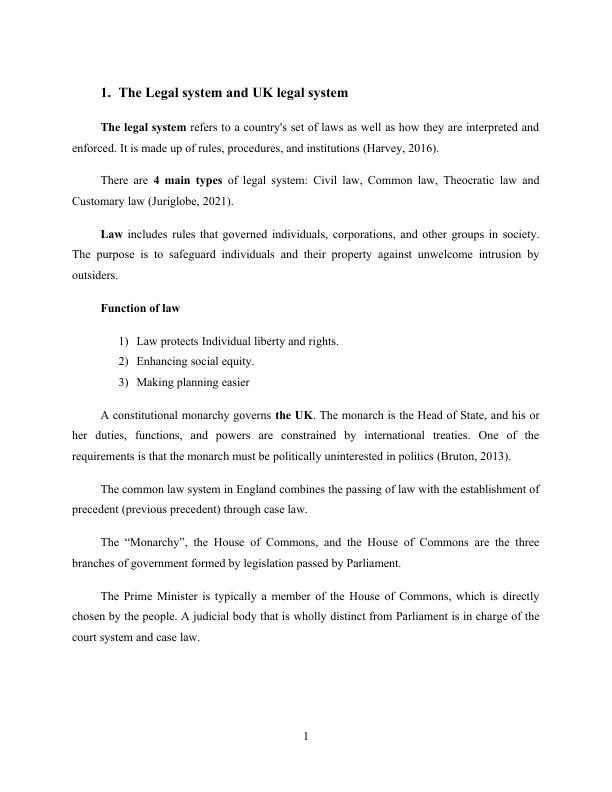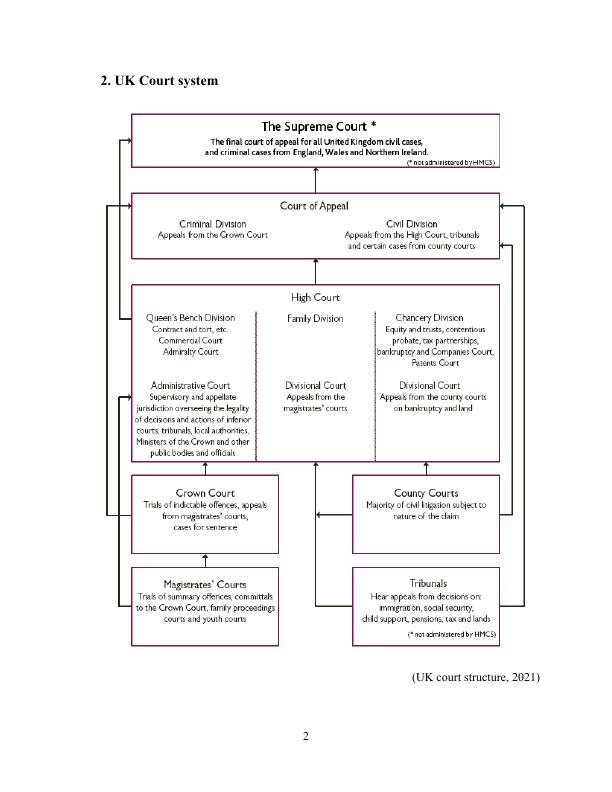The Legal system and UK legal system.
Added on 2022-05-31
13 Pages2583 Words25 Views
1. The Legal system and UK legal system
The legal system refers to a country's set of laws as well as how they are interpreted and
enforced. It is made up of rules, procedures, and institutions (Harvey, 2016).
There are 4 main types of legal system: Civil law, Common law, Theocratic law and
Customary law (Juriglobe, 2021).
Law includes rules that governed individuals, corporations, and other groups in society.
The purpose is to safeguard individuals and their property against unwelcome intrusion by
outsiders.
Function of law
1) Law protects Individual liberty and rights.
2) Enhancing social equity.
3) Making planning easier
A constitutional monarchy governs the UK. The monarch is the Head of State, and his or
her duties, functions, and powers are constrained by international treaties. One of the
requirements is that the monarch must be politically uninterested in politics (Bruton, 2013).
The common law system in England combines the passing of law with the establishment of
precedent (previous precedent) through case law.
The “Monarchy”, the House of Commons, and the House of Commons are the three
branches of government formed by legislation passed by Parliament.
The Prime Minister is typically a member of the House of Commons, which is directly
chosen by the people. A judicial body that is wholly distinct from Parliament is in charge of the
court system and case law.
1
The legal system refers to a country's set of laws as well as how they are interpreted and
enforced. It is made up of rules, procedures, and institutions (Harvey, 2016).
There are 4 main types of legal system: Civil law, Common law, Theocratic law and
Customary law (Juriglobe, 2021).
Law includes rules that governed individuals, corporations, and other groups in society.
The purpose is to safeguard individuals and their property against unwelcome intrusion by
outsiders.
Function of law
1) Law protects Individual liberty and rights.
2) Enhancing social equity.
3) Making planning easier
A constitutional monarchy governs the UK. The monarch is the Head of State, and his or
her duties, functions, and powers are constrained by international treaties. One of the
requirements is that the monarch must be politically uninterested in politics (Bruton, 2013).
The common law system in England combines the passing of law with the establishment of
precedent (previous precedent) through case law.
The “Monarchy”, the House of Commons, and the House of Commons are the three
branches of government formed by legislation passed by Parliament.
The Prime Minister is typically a member of the House of Commons, which is directly
chosen by the people. A judicial body that is wholly distinct from Parliament is in charge of the
court system and case law.
1

2. UK Court system
(UK court structure, 2021)
2
(UK court structure, 2021)
2

The English court system is divided into 5 parts: Supreme Court (formerly the House of
Lords), Court of Appeal, High Court, Crown Court and County Courts, Magistrates’ Courts and
the Tribunals Service.
The House of Lords is the hi ghest court. Its judicial responsibilities are distinct from its
legislative activities.
The High Court serves as a first-instance court for increased civil disputes including a civil
and criminal appeals court. The court is divided to three parts: the Queen's Bench, the Chancery
Division, and the Family Division.
A solitary appellate court, the Court of Appeal. The Civil Division hears appellate
jurisdiction and the County Court, while the Criminal Division hears appeals from the Crown
Court.
3. Sources of law (P1): According to McKinney, 1997, The United Kingdom's legal system is
based on eight sources of law.
3.1. Common Law: known as Case law - is an unwritten act and created by the judge
3.2. Equity: made by the Chancery court in order to ‘fill in the gaps’.
3.3. Legislation: Ministers and local governments founded it using powers granted by
parliament.
3.4. Customs: It is constructed by volunteers using local people's different behaviour habits.
3.5. Conventions: are based on custom and practice. It existed for a very long time.
3.6. Acts of Parliament (Statue Law): is a written law which made by Government.
3.7. European Union Law: created by Institutions of the EU. It can overide to national
legislation.
3.8. European Convention on Human Rights (ECHR): an important role in the UK law.
3
Lords), Court of Appeal, High Court, Crown Court and County Courts, Magistrates’ Courts and
the Tribunals Service.
The House of Lords is the hi ghest court. Its judicial responsibilities are distinct from its
legislative activities.
The High Court serves as a first-instance court for increased civil disputes including a civil
and criminal appeals court. The court is divided to three parts: the Queen's Bench, the Chancery
Division, and the Family Division.
A solitary appellate court, the Court of Appeal. The Civil Division hears appellate
jurisdiction and the County Court, while the Criminal Division hears appeals from the Crown
Court.
3. Sources of law (P1): According to McKinney, 1997, The United Kingdom's legal system is
based on eight sources of law.
3.1. Common Law: known as Case law - is an unwritten act and created by the judge
3.2. Equity: made by the Chancery court in order to ‘fill in the gaps’.
3.3. Legislation: Ministers and local governments founded it using powers granted by
parliament.
3.4. Customs: It is constructed by volunteers using local people's different behaviour habits.
3.5. Conventions: are based on custom and practice. It existed for a very long time.
3.6. Acts of Parliament (Statue Law): is a written law which made by Government.
3.7. European Union Law: created by Institutions of the EU. It can overide to national
legislation.
3.8. European Convention on Human Rights (ECHR): an important role in the UK law.
3

4. P2.
a.The government's role in the law making process
According to (Goetz, 2007), the Bill-to-Act process consists of nine steps, with the
government having a key role in each as a table below:
No Process Role
1 “ The government can submit the application form in green or white paper
format describing the intended law's nature. The government is gradually
producing drafts and bills before they become law, allowing interested parties
to provide feedback and add another layer of scrutiny to the process.
2 The government will prepare the bill with the support of lawyers from the
parliamentary counsel office.
3 The government must introduce legislation in the House of Commons. There
is no debate in the first reading. The government wants to read the bill to
them, establish a date for the second reading, then print, distribute, and
transmit it to all members and the general public.
4 “ The draft bill will be debated and voted on by the government. The goal of
this stage is to provide MPs the opportunity to express their concerns about
the current debate. If there is no discussion, the government will proceed to
the next step.
5 The government examines the bill in detail and has the ability to amend it.
6 The government will transmit a bill to the House of Commons, which will
examine, check, and reconsider the committee members' revisions.
7 At this step, the responsibility of government is to hold a meeting for MPs to
vote on the complete bill.
8
“
After passing the third reading stage, the Army Bill would be referred to the
Lords, where the government would form a Whole House Committee to
check it in the same method that the Standing Committee had during step one.
4
a.The government's role in the law making process
According to (Goetz, 2007), the Bill-to-Act process consists of nine steps, with the
government having a key role in each as a table below:
No Process Role
1 “ The government can submit the application form in green or white paper
format describing the intended law's nature. The government is gradually
producing drafts and bills before they become law, allowing interested parties
to provide feedback and add another layer of scrutiny to the process.
2 The government will prepare the bill with the support of lawyers from the
parliamentary counsel office.
3 The government must introduce legislation in the House of Commons. There
is no debate in the first reading. The government wants to read the bill to
them, establish a date for the second reading, then print, distribute, and
transmit it to all members and the general public.
4 “ The draft bill will be debated and voted on by the government. The goal of
this stage is to provide MPs the opportunity to express their concerns about
the current debate. If there is no discussion, the government will proceed to
the next step.
5 The government examines the bill in detail and has the ability to amend it.
6 The government will transmit a bill to the House of Commons, which will
examine, check, and reconsider the committee members' revisions.
7 At this step, the responsibility of government is to hold a meeting for MPs to
vote on the complete bill.
8
“
After passing the third reading stage, the Army Bill would be referred to the
Lords, where the government would form a Whole House Committee to
check it in the same method that the Standing Committee had during step one.
4

End of preview
Want to access all the pages? Upload your documents or become a member.
Related Documents
Business Advice and Guidance for the Start-Up Payup Finance LTDlg...
|9
|1768
|449
English Legal System: Sources of Law, Contract, Negligence, Precedent, Nuisance, Incorporation of Companylg...
|7
|2526
|116
UK Legal System & Legal Solutions for Start-ups | Deskliblg...
|8
|2032
|176
Legal Systems of Europelg...
|7
|1591
|15
Legal System for Business: Classifications of Law, Source of Law, and UK Law Making Process for Employment Lawlg...
|9
|2512
|198
Law & Legal Systems in the United Kingdomlg...
|10
|2998
|34
